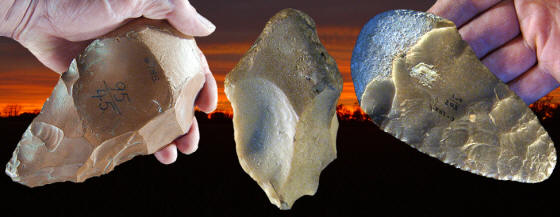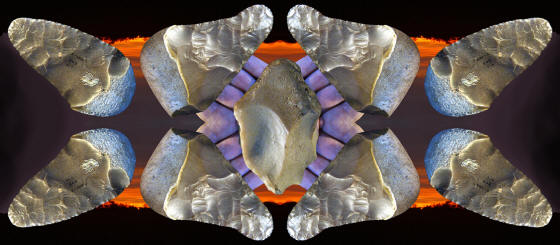|
"---the Tide-Lock
chopper-core may be the first example of a documented Paleolithic piece
on the East coast."------1991,
Mark M. Newell, Sam B. Upchurch, and Albert C. Goodyear, "Tide-Lock
Chopper-Core: Discovery And Analysis Of A Cultural Anomaly In The
Southern Terminus Of The Santee Canal" p. 43.
"From time to time, claims are made for
substantial time-depth for human occupation of the Western Hemisphere,
evidence for which is usually presented in the form of Old World-looking
stone tools."--------1991,
Mark M. Newell, Sam B. Upchurch, and Albert C. Goodyear, "Tide-Lock
Chopper-Core: Discovery And Analysis Of A Cultural Anomaly In The
Southern Terminus Of The Santee Canal" p. 49.
"On October
20, 1988 a small chert pebble (the Tide-Lock
chopper-core) was found by the senior
author in material being screened from a test excavation in the southern
terminus of the Santee Canal, Berkeley County, South Carolina."--------1991,
Mark M. Newell, Sam B. Upchurch, and Albert C. Goodyear, "Tide-Lock
Chopper-Core: Discovery And Analysis Of A Cultural Anomaly In The
Southern Terminus Of The Santee Canal" p. 43.
"The
tool (Kerrville Knife)
has been referred to in early reports as a fist axe, but the thinness of
the blade and use wear on it are peculiar to a knife."----1985,
Gregory Perino, "Selected Preforms, Points And Knives Of The North
American Indians," p. 203.
"It is difficult to imagine a more useful knife
(Kerrville knife)."---------2006,
Bruce B Huckell and W. James Judge, "Paleo-Indian: Plains and
Southwest,"
Handbook Of North American Indians, Environment, Origins, And
Population, Vol. 3, p. 154.

A LOWER PALEOLITHIC ANOMALY
IN VIRGINIA & KERRVILLE KNIVES
TEXAS & VIRGINIA
est. 3,000 TO 1 MILLION YEARS AGO
Anomalies in archaeology are fairly rare but
they do occur, like Marley's ghost, when least expected. The South
Carolina Tide-Lock chopper core is one such example. In fact, this
European "handaxe-like" artifact was described, in its original report,
as a cultural anomaly. This article also describes a very unique knife
form, that occurs in one small area in North America. The reason
Kerrville knives are included is because of their unique appearance to
some Old World handaxes. Although their flaking pattern
does not match any Old World handaxe they do have some similar traits
worthy of mention. |
|
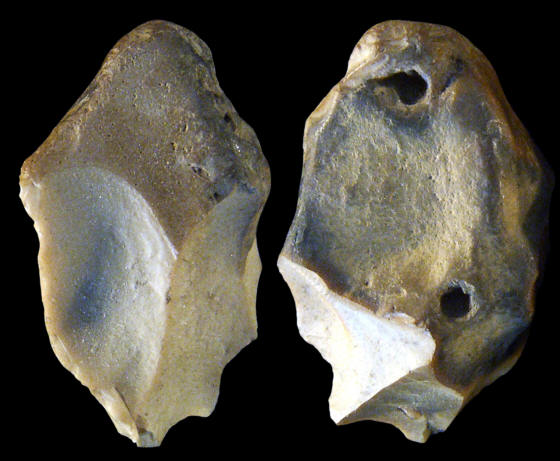
THE TIDE-LOCK CHOPPER CORE
EXCAVATED IN BERKELEY COUNTY,
SOUTH CAROLINA
LOWER PALEOLITHIC TOOL FROM EUROPE
This picture shows both faces of the
Tide-Lock chopper core. It's interesting for the fact that it's been
identified as a Lower Paleolithic chopper core from Europe even
though it was found on a site in South Carolina. It was discovered
in 1988 during a test excavation on a site located in the southern
terminus of the Santee Canal in Berkeley County. A thin section
sample cut from an edge identified the most probable source for the
stone as originating from France. This tool was made from a small
pebble by removing a limited number of percussion flakes with little
or no edge trimming. It was made from a good quality chert and
measures 3 1/4 inches (8.2 cm) long, 2 1/16 inches (5.2 cm) wide,
and 1 1/8 inches (2.8 cm) thick. |
|
|
The "Tide-Lock chopper core" was discovered in 1988
while excavating a test square in the southern terminus of the Santee
Canal in Berkeley County, South Carolina. The excavation was carried out
by the Underwater Antiquities Management Program of the South Carolina
Institution of Archaeology. The artifact was made from a small pebble by
removing a limited number of percussion flakes with little or no edge
trimming. It was initially identified as a
crudely flaked tool with cutting edges on one end. But it's anomalous
characteristics became apparent when it couldn't be identified with any
known local tool types and its lithic material was also puzzling. Prior
to the excavation, archaeologists had speculated that an early period
European stone tool would one day be discovered in ballast stones from
old historic ships. |
|
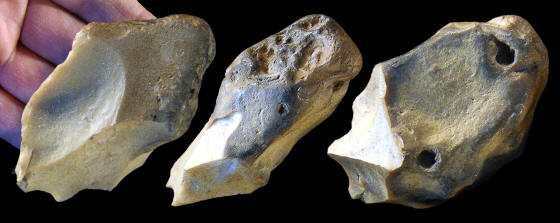
THE TIDE-LOCK CHOPPER CORE
EXCAVATED IN BERKELEY COUNTY,
SOUTH CAROLINA
LOWER PALEOLITHIC TOOL FROM EUROPE
The Tide-Lock chopper core
was intensely studied by researchers in both the United States and
Europe. An initial examination of the "Tide-Lock
chopper core" indicated the prescience of microfossils in the chert
which strongly suggested a deep-sea origin, indicating a possible
European source. Local cherts contain macrofossils which originate from
shallow water environments. Further research involved the removal of a
thin-section from the artifact and submitting the tool and sample to
several specialists in England. The general consensus was that the
artifact most probably originated from Europe and most likely from
France. Jill Cook, Head of the Quaternary Section of the British Museum,
commented that the tool was something, "on the way to being a biface,"
and that, "it would not be out of place in a Lower Paleolithic
assemblage." So, in the final report, the "Tide-Lock chopper core" is
thought to be a Lower Paleolithic biface from France that was deposited
in South Carolina as a ship ballast stone. |
|
|
An initial examination of the "Tide-Lock
chopper core" indicated the prescience of microfossils in the chert
which strongly suggested a deep-sea origin, indicating a possible
European source. Local cherts contain macrofossils which originate from
shallow water environments. Further research involved the removal of a
thin-section from the artifact and submitting the tool and sample to
several specialists in England. The general consensus was that the
artifact most probably originated from Europe and most likely from
France. Jill Cook, Head of the Quaternary Section of the British Museum,
commented that the tool was something, "on the way to being a biface,"
and that, "it would not be out of place in a Lower Paleolithic
assemblage." So, in the final report, the "Tide-Lock chopper core" is
thought to be a Lower Paleolithic biface from France that was deposited
in South Carolina as a ship ballast stone. |
|

KERRVILLE KNIFE
KERR COUNTY, TEXAS
LATE ARCHAIC
est. 3,000 YEARS AGO
This picture shows a
Kerrville knife that was found in Kerr County, Texas. Kerrville knives
are described as a very efficient knife form. Perino wrote that, "It is
difficult to imagine a more useful knife." They are large heavy duty
hand-held tools with outer cortex grip handles. This type of handle is
unique in North American lithic industries. Their development is
directly related to a local and plentiful supply of good quality Edwards
Plateau chert in the form of water worn pebbles. They are described as
excellent skinning tools for large animals and other utilitarian uses.
Edge wear analysis indicates that they were used as knives, rather than
for chopping or scraping. Kerrville knives are found in the same area in
Texas where corner-tang knives are found. They date to the Late Archaic
period to about 3,000 years ago. This Kerrville knife is made of Edwards
Plateau chert and it measures 5 inches (12.7 cm) long. |
|
|
Another unique artifact form that is reminiscent of Old
World tools, are the Kerrville knives from central Texas. In fact, in
early reports they are
referred to as "fist axes." In some ways, they do look more like Old World handaxes than any other tool type in North
America. But only in some ways. They are similar in outline and they
were made from pebbles in a way that left an area of outer cortex (original
pebble surface) on one end. They are
also bifacially flaked. But Kerrville knives are much more refined in
their manufacture than Old World Paleolithic tools, mainly because of their very
skillful use of pressure flaking. Their flaking pattern would never
be mistaken for a handaxe. In 1985, Gregory Perino named them after Kerrville, Texas where many examples have
been found. |
|
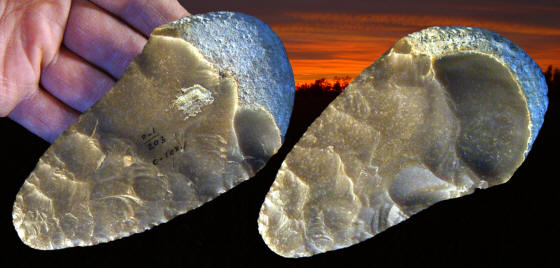
KERRVILLE KNIFE
KERR COUNTY, TEXAS
LATE ARCHAIC
est. 3,000 YEARS AGO
This Kerrville knife was
found in Kerr County, Texas. In early reports they are referred to as
"fist axes." In some ways, they do look more like Old World handaxes
than any other tool type in North America. But only in some ways. They
are similar in outline and they were made from pebbles in a way that
left an area of outer cortex (original
pebble surface) on one end. They are
also bifacially flaked. But Kerrville knives are much more refined in
their manufacture than Old World Paleolithic tools, mainly because of their very
skillful use of pressure flaking. Their flaking pattern would never
be mistaken for a handaxe. In 1985, Gregory Perino named them after Kerrville, Texas where many examples have
been found. This Kerrville knife is made of Edwards Plateau chert and it
measures 4 3/4 inches (12.1 cm) long. |
|
|
The Kerrville knife is a very efficient knife form. Perino wrote that,
"It is difficult to imagine a more useful knife." These are large heavy
duty hand-held tools with outer cortex grip handles. This type of handle
is unique in North American lithic industries. Their development is
directly related to a local and plentiful supply of good quality chert
in the form of water worn pebbles. They are described as excellent
skinning tools for large animals and other utilitarian uses. Edge wear
analysis indicates that they were used as knives, rather than for
chopping or scraping. Kerrville knives are found in the same area in
Texas where corner-tang knives are found. They date to the Late Archaic
period to about 3,000 years ago. |
|
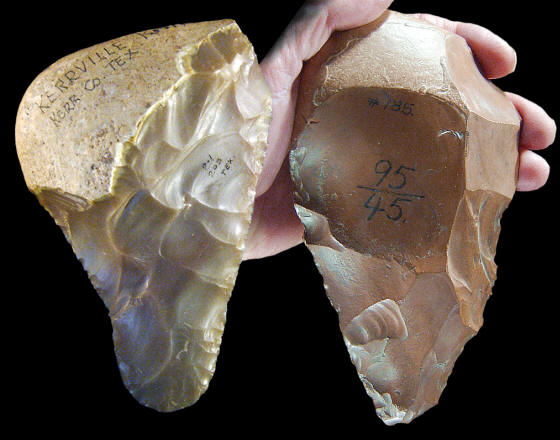
COMPARISON OF KERRVILLE KNIFE TO
PALEOLITHIC HANDAXE
TEXAS & EGYPT
This picture compares a
Kerrville knife from Texas to a Paleolithic handaxe from Egypt. Both
bifaces are generally similar in outline, except that one is pointed and
the other is rounded. Both examples were made from water-worn pebbles
and have an outer cortex grip handle on one end. The difference is
mainly in their flaking patterns. The Kerrville knife is complex and the
handaxe is simple. The Kerrville knife was made with a soft-hammer
antler tool and pressure flaker. The handaxe was made with a hard-hammer
stone tool. The Kerrville knife was manufactured with a more refined
flake removal process that produced a larger number of smaller flakes.
The handaxe took less time to make, with the use of a hard hammer, but
produced a fewer number of flakes, some of which are very large. The
Kerrville knife measures 5 inches (12.7 cm) long and the handaxe
measures 6 15/16 inches (17.3 cm) long. |
|
|
Archaeologists have to be
good detectives. Discovery of anomalous artifacts and unique stone tools
can involve lengthy investigations. Mysteries can appear
any time, like the discovery of an old Norse coin in a shell midden in
Maine or a Tide-Lock chopper core in Virginia. It's the mystery and the
hunt for knowledge that keeps most of us in the game. |
|
"REFERENCES"
1985, Perino, Gregory, "Selected
Preforms, Points And Knives Of The North American Indians."
1991, Newell, Mark M., Upchurch, Sam B., and Goodyear, Albert C.,
"Tide-Lock Chopper-Core: Discovery And Analysis Of A Cultural Anomaly In
The Southern Terminus Of The Santee Canal," Archaeology Of Eastern
North America, Vol., 19, Fall.
2006, Huckell, Bruce B., and Judge, W. James, "Paleo-Indian: Plains and
Southwest,"
Handbook Of North American Indians, Environment, Origins, And
Population, Vol. 3,
|
|
RECENT
LISTINGS HOME
ORDERING |
